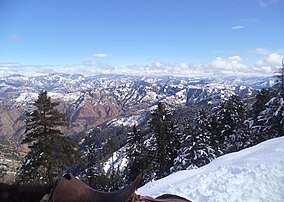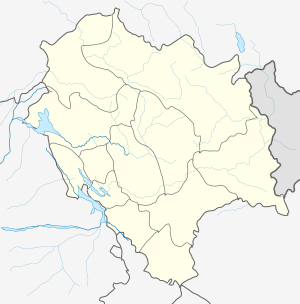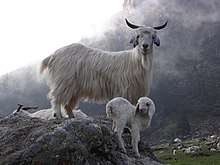Great Himalayan National Park
The Great Himalayan National Park (GHNP), is one of India's national parks, is located in Kullu region in the state of Himachal Pradesh. The park was established in 1984 and is spread over an area of 754 km square km2 at an altitude of between 1500 and 6000 m. The Great Himalayan National Park is a habitat to numerous flora and more than 375 fauna species, including approximately 31 mammals, 181 birds, 3 reptiles, 9 amphibians, 11 annelids, 17 mollusks and 127 insects. They are protected under the strict guidelines of the Wildlife Protection Act of 1972; hence any sort of hunting is not permitted.
| The Great Himalayan National Park | |
|---|---|
IUCN category II (national park) | |
 View of mountains in park | |
 | |
| Location | Himachal Pradesh, India |
| Coordinates | 31°44′N 77°33′E |
| Area | 754 km2 (291 sq mi) |
| Established | 1984 |
| Type | Natural |
| Criteria | x |
| Designated | 2014 (38th session) |
| Reference no. | 1406 |
| State Party | India |
| Region | Asia-Pacific |
In June 2014, the Great Himalayan National Park was added to the UNESCO list of World Heritage Sites.[1] The Unesco World Heritage Site Committee granted the status to the park under the criteria of "outstanding significance for biodiversity conservation".[2]
Biogeography
The GHNP is at the junction of world's two major faunal regions: the oriental to the south and palaearctic to the north. The temperate forest flora-fauna of GHNP represents the westernmost extension of the Sino-Japanese Region. The high altitude ecosystem of the Northwest Himalaya has common plant elements with the adjacent Western and Central Asiatic region. As a result of its 4,100 m elevation range the park has a diversity of zones with their representative flora and fauna, such as alpine, glacial, temperate, and subtropical forests.
These biogeographic elements are result of geological evolution of Himalaya which continues today from the action of plate tectonics and continental drift. Over 100 million years ago, the Indian sub-continent broke off from the large, southern landmass, Gondwanaland and moved north. It eventually slammed into the northern land mass, Laurasia, and formed the gigantic folded mountains of the Himalaya. Due to this union of Gondwanaland and Asiatic landmasses, exchange of flora and fauna was possible and this ultimately led to the unique biogeographical features in the region.
Timeline of creation
It took twenty years from inception to inauguration for GHNP to be realized as part of the Indian national park system. The following is a brief timeline:
1980: Preliminary park survey of the watersheds of Tirthan, Sainj, and Jiwanal in Banjar area of Kullu district 1983: Continued park survey, the Banjar area of Kullu district.
1984: Notification by state of Himachal Pradesh of the intention to create the Great Himalayan National Park with buffer zone.
1987: First Management Plan of the Great Himalayan National Park.
1988: Settlement Proceedings and settling of rights of local communities
1992: The Himachal Wildlife Project re-assesses wildlife abundance, livestock grazing, and herb collection and reviewed the existing management plan.
1994: The Government of HP revised the Notification of intention to include the Sainj Wildlife Sanctuary and the upper Parvati watershed.
1994-1999: Conservation of Biodiversity Project (CoB), the Wildlife Institute of India, Dehradun conducts research to assist in the management of the park.
1999: Declaration of Award upon Completion of Settlement Proceedings. Monetary compensation for individuals who had rights of forest produce in the park area, including a package for providing alternative income generation activities to everybody living in the Eco-development Project Area or Ecozone. The GHNP becomes the latest and newest national park of India. The Conservation of Biodiversity (CoB) Project completed on 31 December 1999.
2014: World Heritage Natural Site status conferred on GHNP on 23 June in the proceedings of the 38th World Heritage Committee meeting in Doha, Qatar.
Biodiversity
Fauna

The Great Himalayan National Park is home to more than 375 faunal species. So far species of 31 mammals, 181 birds, 3 reptiles, 9 amphibians, 11 annelids, 17 mollusks and 127 insects belonging to six orders have been identified and documented. Most of the Himalayan fauna has been given protection under the high priority protection category of Schedule I of the Indian Wildlife (Protection) Act, 1972. The state government of Himachal Pradesh has banned hunting in the state for more than ten years. A trek of 35 to 45 km in any of the park's valleys brings one into the high altitude habitat (3,500 m and above) of animals such as blue sheep, snow leopard, Himalayan brown bear, Himalayan tahr, and musk deer. Best sightings can be made in autumn (September–November) as animals start their seasonal migration to lower altitudes.
Flora
The GHNP also supports a great diversity of plant life, thanks to its wide altitude range and relatively undisturbed habitats. From the lofty pinesand spruces and the great, spreading horse chestnuts of the lower valleys, to the dense cushions and prostrate branches of the alpine herbs and junipers, the park presents an endless variety of vegetation. Although some areas have been modified by grazing, this is one of the few areas of the Western Himalayas where the forests and alpine meadows can be seen in something approaching their original state. The subalpine zone is richest in species, followed by the alpine and upper temperate zones.
References
| Wikimedia Commons has media related to Great Himalayan National Park. |
| Wikivoyage has a travel guide for Great Himalayan National Park. |
- "Six new sites inscribed on World Heritage List". UNESCO. Archived from the original on 25 June 2014. Retrieved 23 June 2014.
- Centre, UNESCO World Heritage. "Six new sites inscribed on World Heritage List". whc.unesco.org. Archived from the original on 16 October 2017. Retrieved 24 April 2018.
